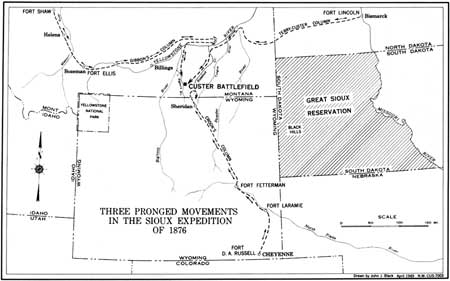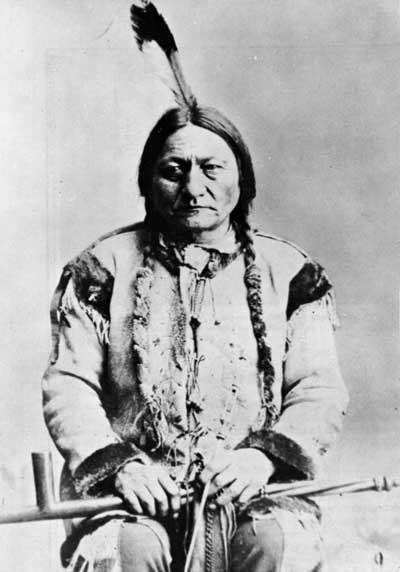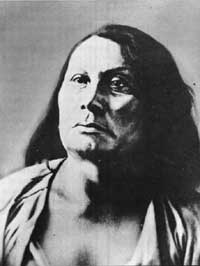|
LITTLE BIGHORN BATTLEFIELD National Monument |
 |

Three Pronged Movements in the Sioux Expedition of 1876
(click on image for an enlargement in a new window)
Indian Movements and Their First Conflict With the
Troops
The first 1876 clash between Indian warriors and soldiers was on March 17. Early that morning about half of General Crook's forces, under Colonel Reynolds, attacked a Northern Cheyenne camp on the west side of Powder River near what is now Moorhead, Mont. The Indians fled, while the soldiers burned the vacated tepees.
During that spring a number of tribes moved about in the region south of the Yellowstone River and between the Powder River and Rosebud Creek. At times they drifted together, but in doing so they found the encampment became so large that difficulties were experienced in obtaining a sufficient supply of food; also the enormous pony herds cropped off the grass too quickly. Small groups of Indians kept in contact with their reservations, obtaining what supplies they could from reservation Indians. With the coming of warm weather, other agency Indians joined the wandering tribes.

Sitting Bull, Uncpapa Medicine Man. While not a fighting chief, he
exercised a strong influence over the Indians.
(Courtesy of the
National Archives.)
 Chief Gall of the Uncpapa Sioux, leading Indian chief at the Battle of the Little Big horn River. (Photograph by D. F. Barry.) |
On June 17, General Crook's troops attacked a combined body of Sioux and Cheyennes, this time on the upper Rosebud Creek, about 20 miles east and south of the present site of the Custer Battlefield. Crook was forced to retreat toward his base in Wyoming, and the Indians then moved toward the Little Bighorn River arriving there on June 24.
It is often difficult to establish exact numbers of Indians involved in different engagements. Estimates of the number in this concentration which was an unusually large one, vary greatly. It may have included between 12,000 and 15,000 Indians, probably as many as 5,000 being warriors. Although there were scattered bands from other tribes, and quite a few were Northern Cheyenne, under Chiefs Two Moon and White Bull, the most were Teton Sioux—Ogallala, under Chiefs Crazy Horse, Low Dog, and Big Road; Uncpapa, under Medicine Man Sitting Bull and Chiefs Gall, Crow King, and Black Moon; Minneconjous, under Chief Hump; and Sans-Arc, under Chief Spotted Eagle.
The camp extended about 3 miles along the west bank of the river immediately west and south of the present monument headquarters, in the direction of Garryowen. On the extreme south rim of the camp were the Uncpapas, and at the opposite end were the Northern Cheyennes. Between them were the tribal camp circles of the other tribes and bands.

|

| History | Links to the Past | National Park Service | Search | Contact |
|
Last Modified: Sat, Sep 28 2002 10:00:00 pm PDT |

